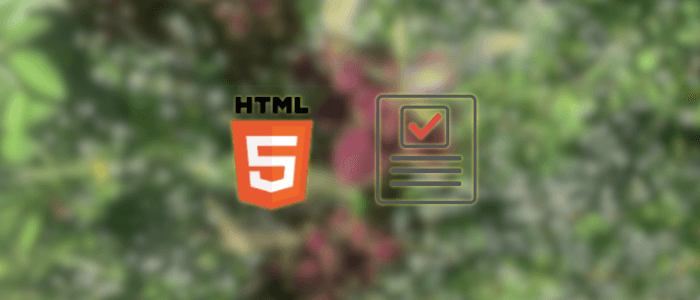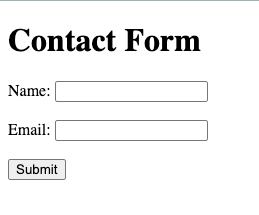Forms are one of the most essential parts of any website. They allow users to interact with applications by submitting data—whether it’s logging in, registering for an account, checking out with an online order, or even filling out a simple contact form. Without forms, the web would be static and far less useful.
In this tutorial, we’ll walk step-by-step through building interactive web forms using pure HTML. You’ll learn how to create text fields, dropdowns, checkboxes, and more. We’ll also explore form validation, structuring, styling, and adding simple JavaScript enhancements. By the end, you’ll be confident in creating user-friendly and professional web forms.
Setting Up the Basics
Let’s start with the foundation: the <form> element. Every HTML form begins with a <form> tag, which wraps all of the input fields and controls.
Here’s the simplest example of a form:
<!DOCTYPE html>
<html lang="en">
<head>
<meta charset="UTF-8">
<meta name="viewport" content="width=device-width, initial-scale=1.0">
<title>Basic HTML Form</title>
</head>
<body>
<h1>Contact Form</h1>
<form action="/submit" method="POST">
<label for="name">Name:</label>
<input type="text" id="name" name="name">
<br><br>
<label for="email">Email:</label>
<input type="email" id="email" name="email">
<br><br>
<input type="submit" value="Submit">
</form>
</body>
</html>Key attributes to know:
-
action– defines where the form data will be sent (e.g., a server endpoint). -
method– specifies how the form data is sent:-
GET– appends data to the URL (useful for search forms). -
POST– sends data securely in the request body (best for sensitive data like login forms).
-
-
name– used to identify the data being submitted.
With this basic structure in place, we’re ready to dive into the different form elements you can use.
Common Form Elements
HTML provides a variety of input types that let users enter different kinds of data. These elements are the building blocks of every form.
1. Text Input
The most basic input type is a single-line text box:
<label for="username">Username:</label>
<input type="text" id="username" name="username">-
type="text"creates a standard text input. -
Always pair inputs with a
<label>to improve accessibility.
2. Password Input
Used for entering sensitive information such as login credentials. The characters are hidden as dots or asterisks.
<label for="password">Password:</label>
<input type="password" id="password" name="password">3. Email Input
Ensures that users enter a valid email address. Some browsers even show a warning if the format isn’t correct.
<label for="email">Email:</label>
<input type="email" id="email" name="email">4. Number Input
Allows only numeric values. You can also add restrictions like min, max, and step.
<label for="age">Age:</label>
<input type="number" id="age" name="age" min="1" max="100">5. Date Input
Let's users pick a date from a calendar widget in most modern browsers.
<label for="birthdate">Birthdate:</label>
<input type="date" id="birthdate" name="birthdate">6. Submit Button
Every form needs a way to be submitted. The simplest way is to use an input of type submit.
<input type="submit" value="Register">💡 Tip: You can also use a <button> element for more styling flexibility:
<button type="submit">Register</button>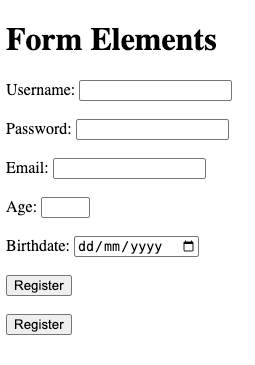
At this point, you’ve seen how to collect the most common types of data: text, passwords, emails, numbers, and dates. Next, let’s explore more advanced input types like radio buttons, checkboxes, dropdown menus, and file uploads to make forms even more interactive.
Advanced Input Types
Beyond the basics, HTML forms support a range of input types that let users make selections, upload files, or enter larger amounts of text. These elements make forms far more versatile.
1. Radio Buttons
Radio buttons let users select only one option from a group. All options must share the same name attribute.
<p>Gender:</p>
<input type="radio" id="male" name="gender" value="male">
<label for="male">Male</label>
<input type="radio" id="female" name="gender" value="female">
<label for="female">Female</label>
<input type="radio" id="other" name="gender" value="other">
<label for="other">Other</label>2. Checkboxes
Checkboxes allow users to select one or more options. Unlike radios, each checkbox can be toggled independently.
<p>Interests:</p>
<input type="checkbox" id="coding" name="interests" value="coding">
<label for="coding">Coding</label>
<input type="checkbox" id="music" name="interests" value="music">
<label for="music">Music</label>
<input type="checkbox" id="sports" name="interests" value="sports">
<label for="sports">Sports</label>3. Dropdown Menu (<select>)
A dropdown menu saves space and lets users pick from a list of options.
<label for="country">Country:</label>
<select id="country" name="country">
<option value="us">United States</option>
<option value="uk">United Kingdom</option>
<option value="ca">Canada</option>
<option value="au">Australia</option>
</select>You can also allow multiple selections:
<select id="languages" name="languages" multiple>
<option value="html">HTML</option>
<option value="css">CSS</option>
<option value="javascript">JavaScript</option>
</select>4. Textarea
For longer text inputs (like comments or messages), use <textarea>.
<label for="message">Message:</label><br>
<textarea id="message" name="message" rows="5" cols="30"></textarea>5. File Upload
Users can upload files using an input of type file.
<label for="resume">Upload Resume:</label>
<input type="file" id="resume" name="resume">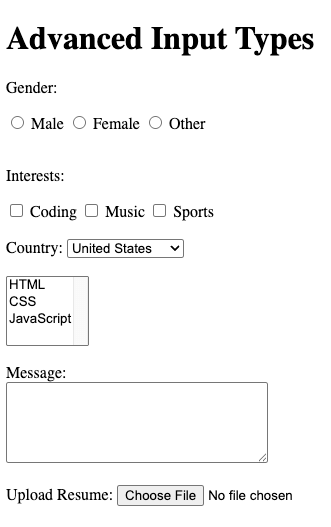
✅ With these advanced elements, you can now build forms that handle more complex input scenarios like surveys, applications, and profile setups.
Next up, we’ll look at Structuring & Grouping Forms using elements like <fieldset>, <legend>, and placeholders to improve usability and readability.
Structuring & Grouping Forms
As forms grow larger, it’s important to keep them organized and user-friendly. HTML provides a few useful elements to structure and group related inputs.
1. Fieldset and Legend
The <fieldset> element groups related to form controls, while <legend> provides a caption for the group.
<form>
<fieldset>
<legend>Personal Information</legend>
<label for="fname">First Name:</label>
<input type="text" id="fname" name="fname"><br><br>
<label for="lname">Last Name:</label>
<input type="text" id="lname" name="lname"><br><br>
<label for="dob">Date of Birth:</label>
<input type="date" id="dob" name="dob">
</fieldset>
</form>This makes the form easier to read and also improves accessibility for screen readers.
2. Placeholders
A placeholder attribute provides a hint inside the input box about the expected value.
<label for="username">Username:</label>
<input type="text" id="username" name="username" placeholder="Enter your username">⚠️ Note: Placeholders are not a replacement for labels. Always use labels for accessibility.
3. Required Fields
The required attribute ensures that the user cannot submit the form without filling in that input.
<label for="email">Email:</label>
<input type="email" id="email" name="email" required>4. Pattern Matching
The pattern attribute lets you define a regular expression for input validation.
Example: requiring a phone number in the format 123-456-7890
<label for="phone">Phone:</label>
<input type="tel" id="phone" name="phone"
pattern="[0-9]{3}-[0-9]{3}-[0-9]{4}"
placeholder="123-456-7890" required>If the user enters data in the wrong format, the browser will show a validation error.
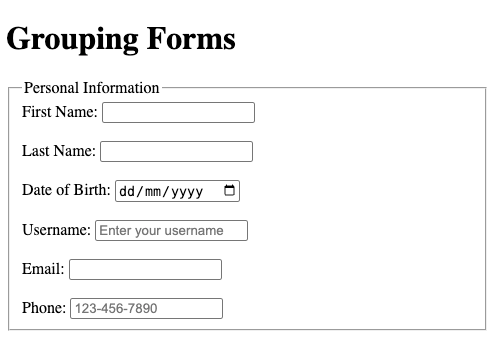
✅ By grouping inputs and using attributes like placeholder, required, and pattern, you make your forms clearer, more usable, and more reliable.
Next, we’ll dive deeper into Form Validation & Best Practices, exploring HTML5’s built-in validation features and how to provide custom error messages.
Form Validation & Best Practices
Validating user input is one of the most important aspects of creating reliable and secure forms. Luckily, HTML5 comes with built-in validation attributes that help ensure the data entered matches the expected format—without requiring extra JavaScript.
1. Required Fields
The required attribute prevents submission if the field is left empty.
<label for="email">Email:</label>
<input type="email" id="email" name="email" required>If the user tries to submit the form without entering an email, the browser will display a warning.
2. Minimum and Maximum Values
For numeric inputs, you can limit the range with min and max.
<label for="age">Age:</label>
<input type="number" id="age" name="age" min="18" max="99" required>Here, users can only enter values between 18 and 99.
3. Length Restrictions
Use minlength and maxlength to control the number of characters.
<label for="username">Username:</label>
<input type="text" id="username" name="username" minlength="4" maxlength="12" required>4. Pattern Matching
The pattern attribute ensures the input matches a specific format using regular expressions.
Example: Accepting only 5-digit ZIP codes:
<label for="zip">ZIP Code:</label>
<input type="text" id="zip" name="zip" pattern="[0-9]{5}" placeholder="12345" required>5. Custom Validation Messages
Browsers show default error messages, but you can customize them with JavaScript for a better user experience.
<input type="text" id="custom" name="custom" required
oninvalid="this.setCustomValidity('Please fill out this field correctly.')"
oninput="this.setCustomValidity('')">-
oninvalidsets a custom error message when validation fails. -
oninputclears the error once the user starts typing again.
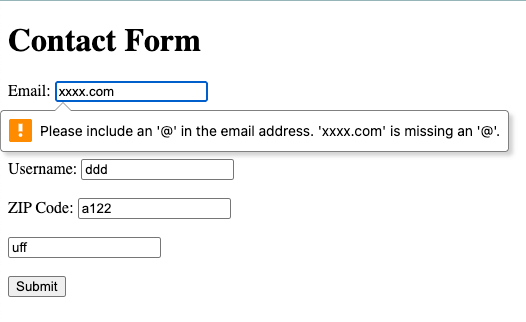
Best Practices for Form Validation
-
✅ Always use labels for better accessibility.
-
✅ Use HTML5 validation first before adding JavaScript.
-
✅ Provide helpful error messages—not just “Invalid input.”
-
✅ Never rely solely on client-side validation. Always validate again on the server side for security.
At this stage, we’ve covered both structuring and validating forms. Next, let’s move into Styling Forms with CSS, where we’ll make forms look more user-friendly and modern.
Styling Forms with CSS
Even a well-structured form can look uninviting if it’s not styled properly. With CSS, you can make your forms more user-friendly, accessible, and visually appealing.
1. Basic Styling for Inputs and Labels
By default, form controls often look plain and inconsistent across browsers. Let’s add some basic styling:
<style>
form {
max-width: 400px;
margin: auto;
padding: 20px;
border: 1px solid #ccc;
border-radius: 8px;
background: #f9f9f9;
}
label {
display: block;
margin-bottom: 8px;
font-weight: bold;
}
input, select, textarea, button {
width: 100%;
padding: 10px;
margin-bottom: 15px;
border: 1px solid #ccc;
border-radius: 4px;
box-sizing: border-box;
}
input:focus, select:focus, textarea:focus {
border-color: #007bff;
outline: none;
}
button {
background-color: #007bff;
color: white;
border: none;
cursor: pointer;
}
button:hover {
background-color: #0056b3;
}
</style>This CSS gives your form:
-
A centered, card-like layout
-
Clear spacing between elements
-
Focus highlighting for inputs
-
A styled, hoverable submit button
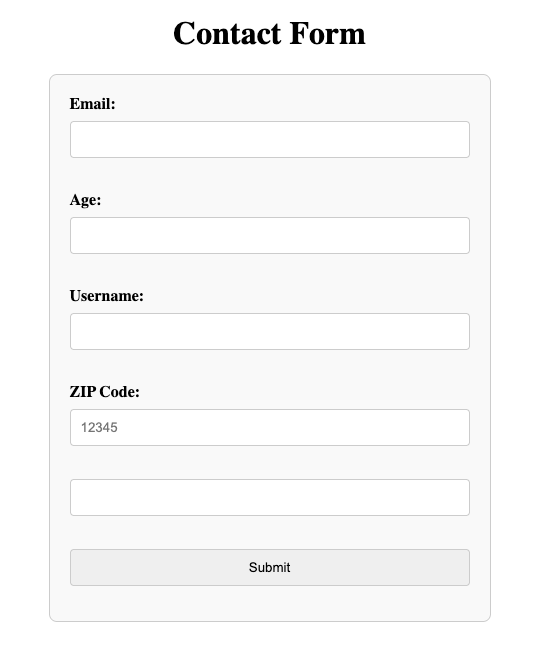
2. Inline vs. Block Layouts
You can control whether inputs appear in a vertical stack (default) or side-by-side.
.form-inline label,
.form-inline input {
display: inline-block;
margin-right: 10px;
width: auto;
}Use inline layouts for short forms like search bars, and block layouts for longer forms.
3. Responsive Forms with Flexbox or Grid
For more complex forms, Flexbox or CSS Grid provides full control over alignment and spacing.
Two-column form using CSS Grid:
.form-grid {
display: grid;
grid-template-columns: 1fr 1fr;
gap: 15px;
}
.form-grid label {
grid-column: span 2;
}This makes it easy to create professional-looking, responsive layouts that adapt to different screen sizes.
4. Accessibility Considerations
-
Use high contrast between text and backgrounds.
-
Ensure focus styles are visible (never remove
outlinewithout replacing it). -
Maintain adequate spacing for touch devices.
✅ With just a bit of CSS, your forms will look cleaner, more approachable, and easier to use on all devices.
Next, we’ll add some interactivity by Enhancing Forms with JavaScript—handling submissions, preventing reloads, and adding custom validation.
Enhancing with JavaScript
While HTML5 validation covers many common cases, JavaScript allows you to add more interactivity, handle custom behaviors, and process data before it’s submitted.
1. Handling Form Submission
By default, forms reload the page when submitted. You can prevent this behavior with JavaScript and process the data instead.
<form id="contactForm">
<label for="name">Name:</label>
<input type="text" id="name" name="name" required>
<label for="email">Email:</label>
<input type="email" id="email" name="email" required>
<button type="submit">Submit</button>
</form>
<script>
const form = document.getElementById('contactForm');
form.addEventListener('submit', function(event) {
event.preventDefault(); // prevent page reload
const name = document.getElementById('name').value;
const email = document.getElementById('email').value;
alert(`Thank you, ${name}! We’ll contact you at ${email}.`);
});
</script>2. Custom Client-Side Validation
You can check inputs with your own rules before submission.
<script>
form.addEventListener('submit', function(event) {
const email = document.getElementById('email').value;
if (!email.includes('@')) {
event.preventDefault();
alert('Please enter a valid email address.');
}
});
</script>3. Real-Time Feedback
Instead of waiting until the form is submitted, you can give users feedback as they type.
<input type="password" id="password" placeholder="Enter password">
<small id="passwordHelp"></small>
<script>
const password = document.getElementById('password');
const help = document.getElementById('passwordHelp');
password.addEventListener('input', function() {
if (password.value.length < 6) {
help.textContent = 'Password must be at least 6 characters long.';
help.style.color = 'red';
} else {
help.textContent = 'Looks good!';
help.style.color = 'green';
}
});
</script>4. Submitting Data with Fetch API
For modern applications, you often want to send data asynchronously (AJAX) without reloading the page.
<script>
form.addEventListener('submit', async function(event) {
event.preventDefault();
const formData = new FormData(form);
const response = await fetch('/submit', {
method: 'POST',
body: formData
});
const result = await response.json();
alert(result.message);
});
</script>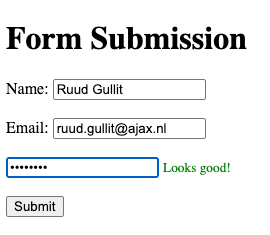
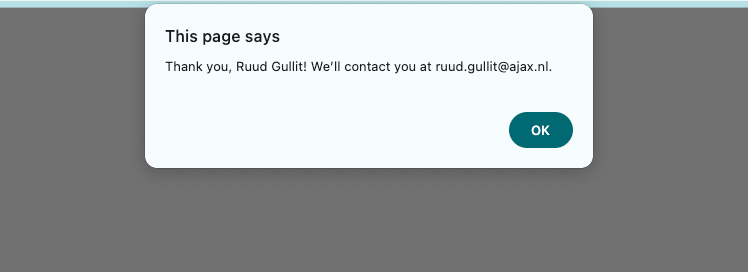
✅ With JavaScript, you can transform static forms into dynamic, user-friendly experiences—from validating inputs in real time to sending data seamlessly to your backend.
Conclusion
In this tutorial, we’ve walked step-by-step through building interactive web forms using HTML, CSS, and a touch of JavaScript. Starting from the basics, we explored:
-
Form structure with
<form>,action, andmethod -
Common input types like text, password, email, number, and date
-
Advanced controls such as radio buttons, checkboxes, dropdowns, file uploads, and textareas
-
Grouping and structuring forms with
<fieldset>,<legend>, placeholders, required fields, and patterns -
Form validation using HTML5 attributes and custom validation messages
-
Styling with CSS to make forms clean, responsive, and accessible
-
JavaScript enhancements for handling submissions, real-time validation, and async requests
With these tools, you can now build professional, user-friendly forms that not only look good but also improve user experience.
Next Steps
If you want to take your forms even further, here are some ideas:
-
Integrate with a backend (e.g., Node.js, PHP, Python, or Java) to store submitted data.
-
Add stronger validation libraries for more complex scenarios.
-
Use frameworks like React, Angular, or Vue to create fully dynamic forms.
Forms are the backbone of interactivity on the web. With the knowledge you’ve gained here, you’re well-equipped to design secure, reliable, and engaging forms for any project.
You can find the full source code on our GitHub.
That's just the basics. If you need more deep learning about HTML, you can take the following cheap course:
- The Complete Full-Stack Web Development Bootcamp
- Build Responsive Real-World Websites with HTML and CSS
- The HTML & CSS Bootcamp 2025 Edition
- The Complete Guide to HTML
- Learn HTML and CSS in 7 Days | Web Developer Bootcamp
- HTML, CSS, & JavaScript - Certification Course for Beginners
- 50 Projects In 50 Days - HTML, CSS & JavaScript
- Modern HTML & CSS From The Beginning 2.0 (2024 Revamp)
- HTML - Introduction to HTML Web Development
- HTML & CSS Masterclass 2025 — From Beginner to Pro
Thanks!
